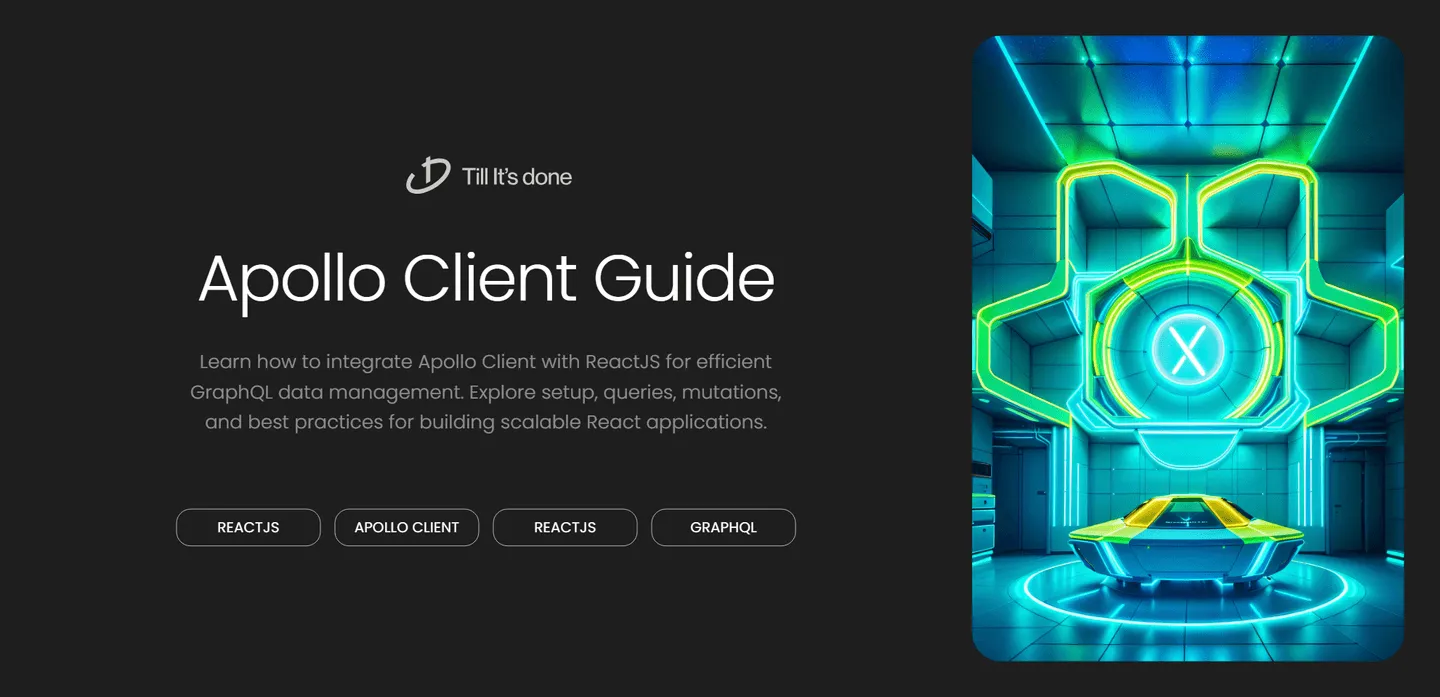- Services
- Case Studies
- Technologies
- NextJs development
- Flutter development
- NodeJs development
- ReactJs development
- About
- Contact
- Tools
- Blogs
- FAQ
Getting Started with Apollo Client in ReactJS
Explore setup, queries, mutations, and best practices for building scalable React applications.

Getting Started with Apollo Client in ReactJS

Are you tired of managing complex API calls and state management in your React applications? Apollo Client might just be the solution you’re looking for. In this guide, we’ll explore how to integrate Apollo Client with ReactJS to create efficient and scalable applications that handle GraphQL data like a breeze.
What is Apollo Client?
Apollo Client is a comprehensive state management library that simplifies the process of working with GraphQL APIs in your frontend applications. Think of it as your personal data courier, seamlessly fetching, caching, and managing data between your React application and your GraphQL server.

Setting Up Apollo Client
Let’s start by adding Apollo Client to your React project. First, install the necessary dependencies:
npm install @apollo/client graphqlNext, create your Apollo Client instance. In your project’s root file (usually index.js or App.js), add the following configuration:
import { ApolloClient, InMemoryCache, ApolloProvider } from '@apollo/client';
const client = new ApolloClient({ uri: 'YOUR_GRAPHQL_API_ENDPOINT', cache: new InMemoryCache()});Wrap your React application with the ApolloProvider to make the client available throughout your component tree:
function App() { return ( <ApolloProvider client={client}> <YourAppComponents /> </ApolloProvider> );}Making Your First Query
Now comes the exciting part - fetching data! Apollo Client provides the useQuery hook for making GraphQL queries in your components:
import { useQuery, gql } from '@apollo/client';
const GET_BOOKS = gql` query GetBooks { books { title author } }`;
function BookList() { const { loading, error, data } = useQuery(GET_BOOKS);
if (loading) return <p>Loading...</p>; if (error) return <p>Error :(</p>;
return ( <ul> {data.books.map(book => ( <li key={book.title}> {book.title} by {book.author} </li> ))} </ul> );}
Mutations and Cache Updates
Apollo Client really shines when it comes to mutations. Here’s how you can update data on your server and automatically update your UI:
const ADD_BOOK = gql` mutation AddBook($title: String!, $author: String!) { addBook(title: $title, author: $author) { title author } }`;
function AddBook() { const [addBook] = useMutation(ADD_BOOK, { update(cache, { data: { addBook } }) { cache.modify({ fields: { books(existingBooks = []) { const newBookRef = cache.writeFragment({ data: addBook, fragment: gql` fragment NewBook on Book { title author } ` }); return [...existingBooks, newBookRef]; } } }); } });}Best Practices and Tips
- Always use fragments to share common fields between queries
- Implement proper error handling and loading states
- Take advantage of Apollo Client’s powerful caching capabilities
- Use the Apollo Developer Tools browser extension for debugging
- Consider implementing optimistic UI updates for better user experience

With Apollo Client, you’ve got a powerful toolkit at your disposal for building robust React applications with GraphQL. The combination of declarative data fetching, intelligent caching, and seamless integration with React makes it an invaluable addition to your development stack.
Start small, experiment with the features, and gradually incorporate more advanced concepts as you become comfortable with the basics. Happy coding!
 สร้างเว็บไซต์ 1 เว็บ ต้องใช้งบเท่าไหร่? เจาะลึกทุกองค์ประกอบ website development cost อยากสร้างเว็บไซต์แต่ไม่มั่นใจในเรื่องของงบประมาณ อ่านสรุปเจาะลึกตั้งแต่ดีไซน์, ฟังก์ชัน และการดูแล พร้อมตัวอย่างงบจริงจาก Till it’s done ที่แผนชัด งบไม่บานปลายแน่นอน
สร้างเว็บไซต์ 1 เว็บ ต้องใช้งบเท่าไหร่? เจาะลึกทุกองค์ประกอบ website development cost อยากสร้างเว็บไซต์แต่ไม่มั่นใจในเรื่องของงบประมาณ อ่านสรุปเจาะลึกตั้งแต่ดีไซน์, ฟังก์ชัน และการดูแล พร้อมตัวอย่างงบจริงจาก Till it’s done ที่แผนชัด งบไม่บานปลายแน่นอน  Next.js สอน 14 ขั้นตอนเบื้องต้น: สร้างโปรเจกต์แรกใน 30 นาที เริ่มต้นกับ Next.js ใน 14 ขั้นตอนเพียงแค่ 30 นาที พร้อม SSR/SSG และ API Routes ด้วยตัวอย่างโค้ดง่าย ๆ อ่านต่อเพื่อสร้างโปรเจ็กต์แรกได้ทันทีที่นี่
Next.js สอน 14 ขั้นตอนเบื้องต้น: สร้างโปรเจกต์แรกใน 30 นาที เริ่มต้นกับ Next.js ใน 14 ขั้นตอนเพียงแค่ 30 นาที พร้อม SSR/SSG และ API Routes ด้วยตัวอย่างโค้ดง่าย ๆ อ่านต่อเพื่อสร้างโปรเจ็กต์แรกได้ทันทีที่นี่  วิธีสมัคร Apple Developer Account เพื่อนำแอปขึ้น App Store ทีละขั้นตอน อยากปล่อยแอปบน App Store ระดับโลก มาอ่านคู่มือสมัคร Apple Developer Account พร้อมเคล็ดลับ TestFlight และวิธีอัปโหลดที่ง่ายในบทความเดียวนี้ได้เลย
วิธีสมัคร Apple Developer Account เพื่อนำแอปขึ้น App Store ทีละขั้นตอน อยากปล่อยแอปบน App Store ระดับโลก มาอ่านคู่มือสมัคร Apple Developer Account พร้อมเคล็ดลับ TestFlight และวิธีอัปโหลดที่ง่ายในบทความเดียวนี้ได้เลย  TypeScript Interface คืออะไร? อธิบายพร้อมวิธีใช้และข้อแตกต่างจาก Type เรียนรู้วิธีใช้ TypeScript Interface เพื่อสร้างโครงสร้างข้อมูลที่ปลอดภัยและเข้าใจง่าย พร้อมเปรียบเทียบข้อดีข้อแตกต่างกับ Type ที่คุณต้องรู้ ถูกรวมเอาไว้ในบทความนี้แล้ว
TypeScript Interface คืออะไร? อธิบายพร้อมวิธีใช้และข้อแตกต่างจาก Type เรียนรู้วิธีใช้ TypeScript Interface เพื่อสร้างโครงสร้างข้อมูลที่ปลอดภัยและเข้าใจง่าย พร้อมเปรียบเทียบข้อดีข้อแตกต่างกับ Type ที่คุณต้องรู้ ถูกรวมเอาไว้ในบทความนี้แล้ว  Material-UI (MUI) คืออะไร อยากสร้าง UI สวยงามและเป็นมืออาชีพในเวลาอันรวดเร็วใช่ไหม มาทำความรู้จักกับ Material-UI (MUI) ที่ช่วยให้คุณพัฒนาแอปพลิเคชันบน React ได้ง่ายและดูดีในทุกอุปกรณ์
Material-UI (MUI) คืออะไร อยากสร้าง UI สวยงามและเป็นมืออาชีพในเวลาอันรวดเร็วใช่ไหม มาทำความรู้จักกับ Material-UI (MUI) ที่ช่วยให้คุณพัฒนาแอปพลิเคชันบน React ได้ง่ายและดูดีในทุกอุปกรณ์  เปรียบเทียบ 3 วิธีติดตั้ง install node js บน Ubuntu: NVM vs NodeSource vs Official Repo แบบไหนดีที่สุด? เรียนรู้วิธีติดตั้ง Node.js บน Ubuntu ด้วย NVM, NodeSource หรือ Official Repo เลือกวิธีที่เหมาะกับความต้องการของคุณ พร้อมเปรียบเทียบ เพื่อการพัฒนาที่มีประสิทธิภาพ!
เปรียบเทียบ 3 วิธีติดตั้ง install node js บน Ubuntu: NVM vs NodeSource vs Official Repo แบบไหนดีที่สุด? เรียนรู้วิธีติดตั้ง Node.js บน Ubuntu ด้วย NVM, NodeSource หรือ Official Repo เลือกวิธีที่เหมาะกับความต้องการของคุณ พร้อมเปรียบเทียบ เพื่อการพัฒนาที่มีประสิทธิภาพ! พูดคุยกับซีอีโอ
We'll be right here with you every step of the way.
We'll be here, prepared to commence this promising collaboration.
Whether you're curious about features, warranties, or shopping policies, we provide comprehensive answers to assist you.


